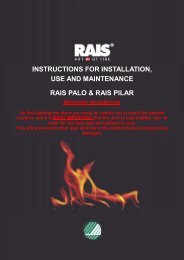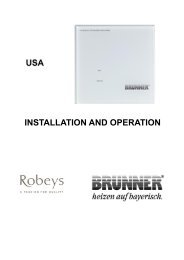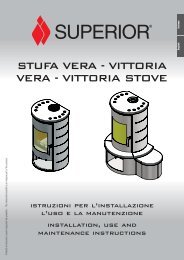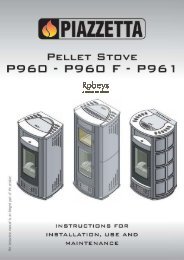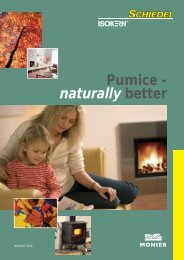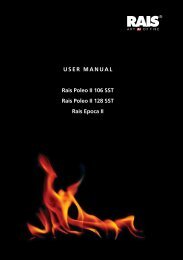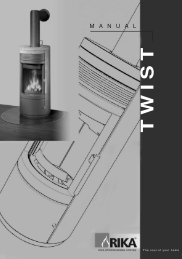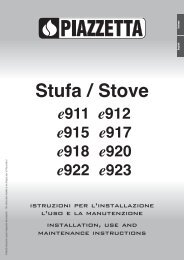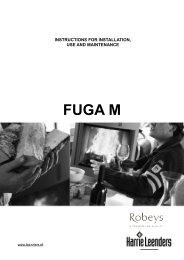Stufa 555 T C/MK per rivestimenti COSTELLAZIONI Kaminofen 555 ...
Stufa 555 T C/MK per rivestimenti COSTELLAZIONI Kaminofen 555 ...
Stufa 555 T C/MK per rivestimenti COSTELLAZIONI Kaminofen 555 ...
You also want an ePaper? Increase the reach of your titles
YUMPU automatically turns print PDFs into web optimized ePapers that Google loves.
Overheating and safetySome parts of the stove (door, handle, controls, ceramic parts) can reach very high tem<strong>per</strong>atures while the fire isalight.Remember to maintain the safety distances given previously.Please follow carefully the instructions.Use the glove provided when stoking the stove with fuel and when o<strong>per</strong>ating the controls.If any part of the stove/Fireplace becomes red while it is alight, this means that it is overheating.Immediately stop adding fuel. Close the door and controls and check that the redness is reducing.If smoke leaks out of any part of the stove or the flue, immediately stop adding fuel and air. Once thestove/fireplace has cooled down check the reason for the leak and if necessary ask your supplier for specialistassistance. In the meantime air the room.FuelThe following fuels may be used: wood (beech or birch) also in the form of wood Brickettes, according to regulationDIN 51731, size group HP2.Only use these materials as fuel. Never use damp wood or wood containing pitch.Waste (rubbish), painted wood or wood covered with synthetic substances must not be used as these coulddamage the stove, the smoke stack and, not least, the natural environment.• The characteristics of the wood or fuel used (dampness; size; density) influence the quality of combustion. Forthis reason it is important to know about the different types of wood. We offer some relevant information below.• Firewood is usually subdivided into two types: hardwood and softwood.• The characteristics of hardwood are solid, heavy wood, providing the fire with a sustained and <strong>per</strong>sistentflame.• Softwood is a less dense and lighter weight wood, which gives the fire a flame which is lively but of shortduration, and which for the same level of output requires a higher level of consumption. Another characteristicof any type of softwood is that it may be resinous, thus creating various combustion problems. For example:thick soot; few embers; red hot particles; sudden sharp cracking sounds; the need to clean the stove and thesmoke stack more frequently.HARDWOODSOFTWOODWild maple Wild cherry Ailanthus AspenLaurel Hazel Bagolaro SaliconeBirch * Walnut Carob Common elderWhite hornbeam Olive Chestnut LimeBlack hornbeam Siberian elm * CypressTurkey oak Pear Cornelian cherryCherry Wild peach MulberryBeech Plane Neapolitan AlderAsh Wild thorn Black alderHolm oak False acacia Manna ashLaburnam Roverella Cypress poplar*Not always regarded as a HARDWOOD53



